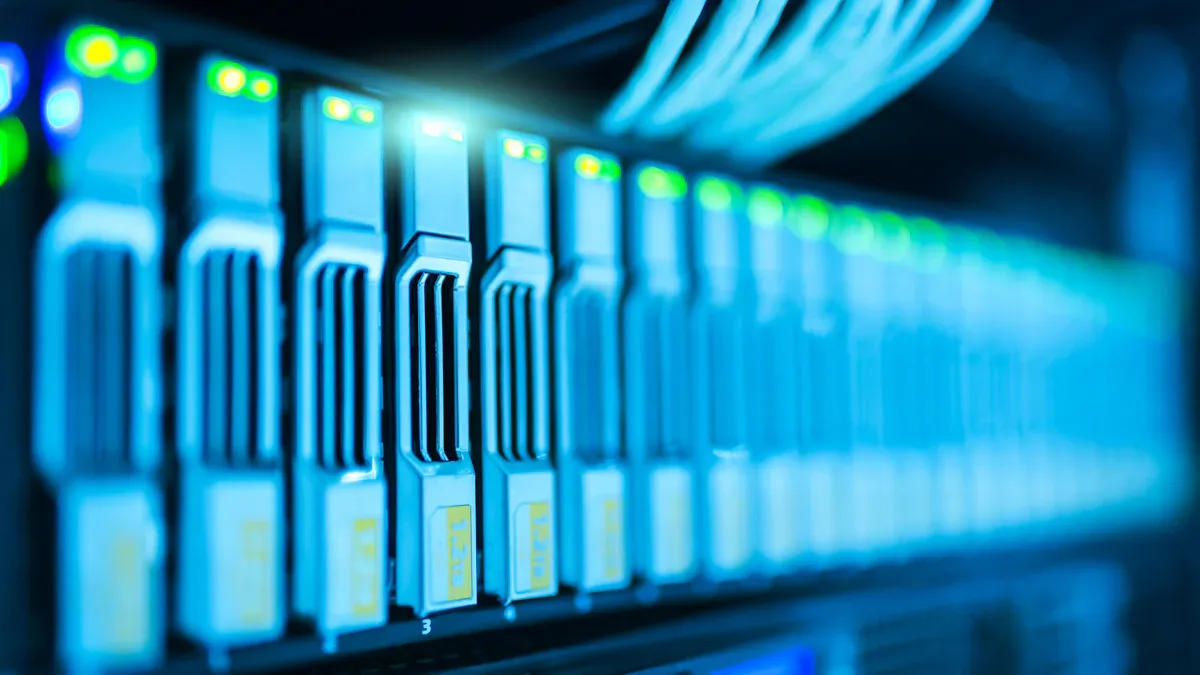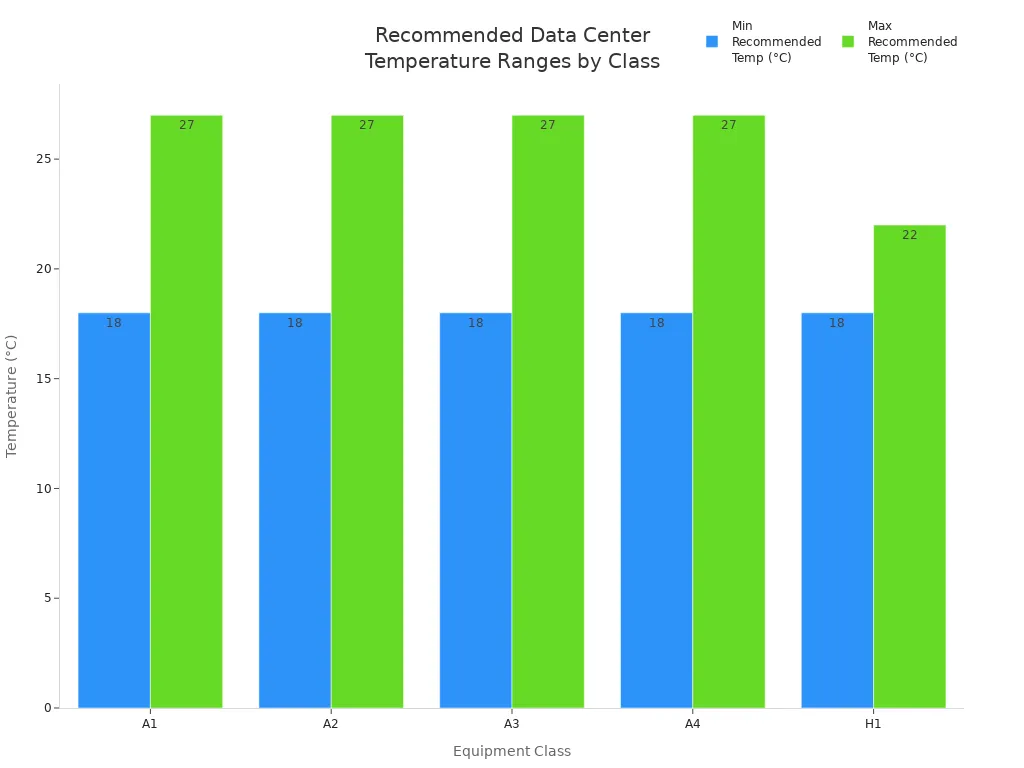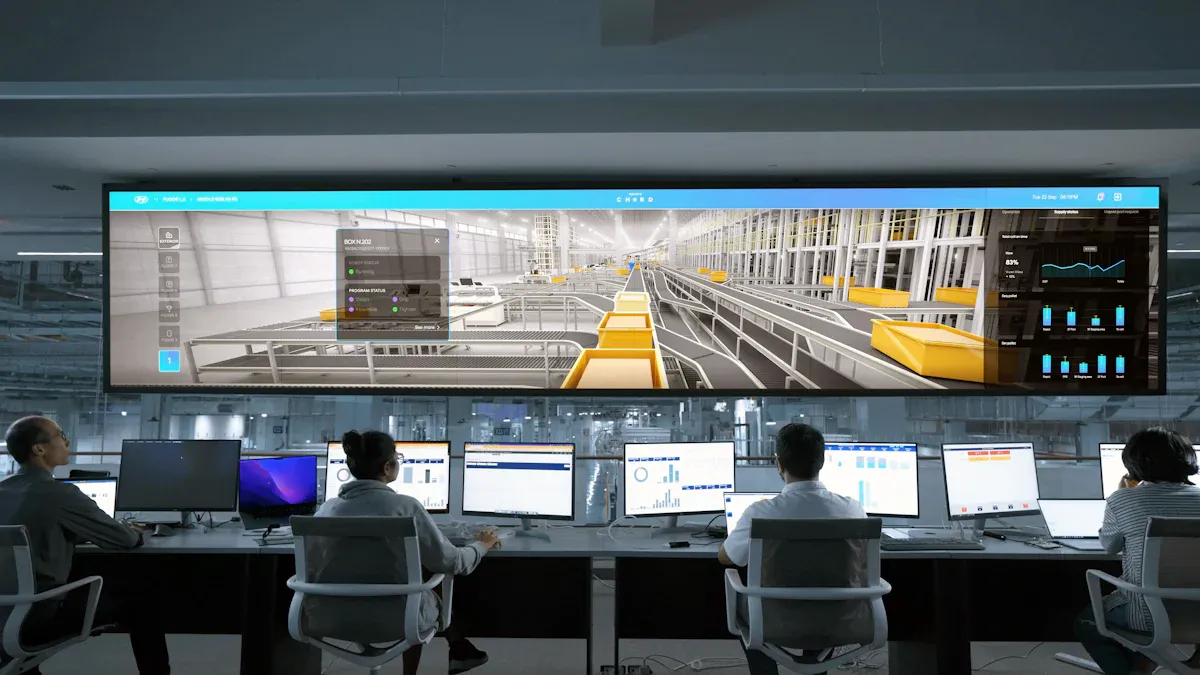6 Steps to Find the Best Environment Monitoring System for Any Data Center Size

Ready to find the right Environment Monitoring System for your data center? Use this straightforward checklist to make your decision easier, whether you manage a small server room or a large facility.
Assess size
Identify key parameters
Select system type
Set up real-time alerts
Plan integration
Compare and choose
As data centers grow, monitoring needs become more complex. Large facilities must manage water use, regulatory demands, and reliability, making advanced solutions essential.
Key Takeaways
Start by assessing your data center’s size and layout to choose the right sensors and coverage.
Monitor key factors like temperature, humidity, and water leaks to protect your equipment and prevent failures.
Decide between wired and wireless systems based on reliability, installation ease, and future growth needs.
Set up real-time alerts and clear reports to catch problems early and respond quickly.
Choose a system that integrates well with your existing setup and offers strong vendor support and cost balance.
1. Assess Size

Facility Scale
Start by looking at the physical size and layout of your data center. The right Environment Monitoring System depends on how much space you need to cover and the complexity of your setup. Here are some steps to help you:
Inventory your assets: List all servers, network devices, and applications. This helps you see which areas need the most protection.
Check your layout: Divide your data center into zones, such as server rooms, network closets, and storage areas. Use firewalls to control communication between these zones.
Review infrastructure: Look at raised floors, cooling systems, electrical setups, and fire protection. Each part may need different sensors.
Assess security layers: Make sure you have strong perimeter security, locked doors, and cabinet controls.
Consider environmental risks: Think about natural disasters, flooding, or nearby hazards. Place sensors in areas most at risk.
Tip: Larger rooms or multi-tier facilities need more sensors. Place them away from doors, windows, and direct airflow to avoid false readings.
The table below shows how different layout aspects affect sensor placement:
Layout Aspect | Impact on Sensors |
|---|---|
Rack Density | More racks mean more sensors per rack or row, especially at top, middle, and bottom. |
Room Size | Bigger rooms need more in-room sensors for accurate monitoring. |
Airflow Patterns | Hot-aisle/cold-aisle setups require sensors in key spots to track temperature changes. |
Cooling Design | Raised floors or overhead cooling change where you should place sensors. |
Environmental Factors | Windows, doors, and location may require extra sensors for reliable readings. |
Equipment Type
The type of equipment you use changes how you set up your monitoring. Here are some key points:
Rack-mounted equipment: You need several temperature sensors per rack. ASHRAE recommends at least six sensors per rack—top, middle, and bottom on both the front and back. Some experts say three sensors may be enough if placed at the bottom front, top front, and top back. This setup helps you catch hot spots before they become a problem.
Room-level monitoring: Place temperature and humidity sensors in hot zones, near cooling units, and throughout the room. This keeps the whole area within safe limits.
Water leak sensors: Put these under air conditioning units, raised floors, and around the room’s edge.
Sensor types: Small rooms often use wired sensors. Large data centers may use daisy-chained or wireless sensors to save on cost and reduce complexity.
Remember: Rack temperature can be very different from room temperature. Relying only on room-level sensors may delay your response to heat issues.
By matching your facility scale and equipment type to your monitoring setup, you ensure your Environment Monitoring System covers all critical areas.
2. Key Parameters
Monitoring the right environmental factors keeps your data center safe and efficient. You need to focus on the most critical parameters to prevent downtime and equipment failure.
Temperature & Humidity
You should always track temperature and humidity. These two factors have the biggest impact on your hardware’s performance and lifespan. If the temperature rises above 30°C (85°F), you risk overheating and equipment failure. If humidity drops too low, static electricity can damage sensitive parts. High humidity can cause corrosion.
Tip: Keep your data center between 20°C and 24°C (68°F to 75°F) with relative humidity between 45% and 55%. Set early warning alerts at 40% and 60% humidity, and critical alerts at 30% and 70%.
Here is a quick reference table for recommended ranges:
Equipment Class | Recommended Temperature (°C) | Recommended Temperature (°F) | Recommended Relative Humidity (%) |
|---|---|---|---|
A1 | 18 to 27 | 64.4 to 80.6 | 50 to 70 |
A2 | 18 to 27 | 64.4 to 80.6 | 50 to 70 |
A3 | 18 to 27 | 64.4 to 80.6 | 50 to 70 |
A4 | 18 to 27 | 64.4 to 80.6 | 50 to 70 |

You should use multiple sensors per rack—top, middle, and bottom—to catch hot spots. Place sensors near air intakes and cooling units for the best results. Continuous, real-time monitoring with automated systems helps you spot problems before they cause damage.
Water & Aisle Conditions
Water leaks can shut down your data center in minutes. You need high-sensitivity leak detection sensors under raised floors, near cooling units, and along aisles. Leak detection cables provide coverage for large areas and send real-time alerts if they sense moisture.
Install leak detection alarms with both audible and visual signals.
Use durable materials like PVC or stainless steel for sensors to withstand harsh conditions.
Place sensors in high-risk zones, such as under HVAC units and around the perimeter.
Aisle conditions also matter. Monitor airflow and air quality to prevent overheating and contamination. Make sure your Environment Monitoring System tracks these parameters and sends alerts if conditions change.
Note: Regularly test and calibrate all sensors. This ensures your monitoring system stays accurate and reliable.
3. System Type
Wired vs. Wireless
When you choose an Environment Monitoring System, you need to decide between wired and wireless options. Each type has strengths and weaknesses. The table below highlights the main differences:
Aspect | Wired Systems | Wireless Systems |
|---|---|---|
Reliability | High stability due to physical cabling; less susceptible to interference and signal loss. | Improved reliability with modern tech but can face signal interference from obstacles; may need repeaters or gateways. |
Installation | Complex, labor-intensive, costly; requires extensive cabling through walls/floors and additional network hardware. | Easier and faster installation; minimal disruption; no physical cables needed; lower installation costs. |
Scalability | Limited flexibility; expanding requires additional cabling and structural modifications. | Highly scalable; new sensors can be added without major infrastructure changes. |
Security | Generally more secure due to physical connections. | More vulnerable to interception; security depends on communication channels; proprietary mesh networks can mitigate risks. |
Maintenance | May require more maintenance related to physical cables and connections. | Requires monitoring of signal integrity and battery replacement in sensors. |
Tip: Wired systems offer strong reliability and security, but you may face higher costs and more complex installation. Wireless systems provide flexibility and easier setup, but you need to monitor battery life and signal strength.
Maintenance also differs between the two. Wired systems often have higher total costs because you must manage cables and handle repairs. Moving or changing cables can be expensive and time-consuming. Wireless systems avoid these issues, but you need to replace batteries and check for signal problems.
Scalability
As your data center grows, your Environment Monitoring System must adapt. Scalability becomes a key factor. Leading systems let you add new sensors or modules easily. Wireless technology makes this process simple. You can place new sensors wherever you need them, without worrying about running cables through walls or floors.
You can expand coverage by adding sensors in new racks, dead air spaces, or critical airflow points.
Integration with HVAC systems allows real-time adjustments as your infrastructure changes.
Modular sensor networks and expert manufacturer support help you maintain accuracy and reliability as you scale up.
Note: Choose a system that supports easy expansion. This ensures your monitoring keeps pace with your data center’s needs.
4. Real-Time Alerts

Staying ahead of hazards in your data center means you need instant notifications and clear reporting. Real-time alerts help you act before small issues become major problems.
Notifications
You should set up your Environment Monitoring System to deliver alerts through multiple channels. The most effective systems use a mix of email, SMS, and chat notifications. This approach ensures the right people receive alerts quickly, no matter where they are.
Use tiered alerts to match the severity of each issue:
Low-severity: Log these for later review.
Moderate-severity: Send these by email or chat to avoid unnecessary panic.
High-severity: Escalate these with paging systems for immediate action.
Centralized monitoring lets you manage alerts from several locations in one place, improving your response time.
Customizable alarm thresholds help you fine-tune sensitivity, so you avoid false alarms and focus on real threats.
Redundant alerting systems, such as using two master stations from different vendors, increase reliability.
Monitor power, battery, and generator status to prevent failures before they happen.
Tip: Internal sensors in monitoring units can send instant alerts about temperature or humidity changes, helping you respond to cooling issues fast.
Reporting
Customizable dashboards and reporting features make your job easier. You can personalize dashboards to show only the most important metrics and KPIs. This setup gives you quick access to critical data, helping you make informed decisions without delay. Collaborative dashboard features let your team share information, assign tasks, and communicate efficiently, which reduces errors and streamlines your workflow.
Customizable reports use filters, widgets, and role-based access to deliver the right data to the right people. You can expand monitoring with custom scripts, track costs, and get optimization tips. These features support proactive management and continuous improvement.
Automated compliance dashboards and real-time scans help you meet regulations like SOC 2 Type II and ISO 27001.
Immutable logs and detailed reporting provide reliable audit trails for regulatory checks.
Configuration management tools track changes and alert you to unauthorized modifications.
Note: An intuitive dashboard interface helps you monitor performance at every level, making it easier to spot issues and adjust operations quickly.
5. Integration
Cloud & Mobile
You need to monitor your data center from anywhere. Cloud integration gives you real-time access to your Environment Monitoring System, even when you are offsite. Many leading platforms support this feature. The table below shows some of the most widely used cloud platforms for integrating environment monitoring:
Platform | Key Features | Cloud Focus | Notes |
|---|---|---|---|
CloudHealth by VMware | Multi-cloud monitoring, cost management, governance | AWS, Azure, GCP | Unified dashboard for all environments |
Nutanix | Proactive monitoring, automation | Multi-cloud, hybrid | Hyper-converged infrastructure |
TotalCloud | Real-time monitoring, workflow automation | AWS, others | Custom dashboards, auto-remediation |
Concierto Cloud | AI anomaly detection, unified visibility | AWS, Azure, GCP, on-prem | Zero-code automations |
Turbo360 | Azure-focused, anomaly detection | Azure | Cost allocation, operational efficiency |
Terraform | Infrastructure as code, automation | Multi-cloud, hybrid | Supports Kubernetes, network infrastructure |
OpenStack | Orchestration, fault management | Private, hybrid | Open-source, customizable |
CloudBolt | Service health, automation, governance | Hybrid, multi-cloud | Cost optimization, multi-hypervisor support |
Mobile integration lets you receive alerts and view dashboards on your phone or tablet. You can respond to incidents faster and keep your team informed. Security remains a top priority. You should use strong access controls, multi-factor authentication, and data encryption. Monitoring user activities and cloud resources helps you spot threats early. Automation and API integration also improve your ability to enforce security policies and respond to incidents.
Tip: Choose a system that supports both cloud and mobile access. This gives you flexibility and control, no matter where you are.
Compatibility
You must ensure your new monitoring system works with your existing infrastructure. Compatibility affects how quickly you can deploy and how much you spend on upgrades. Many data centers use legacy systems with outdated protocols and limited data sharing. These challenges can slow down integration.
Adaptable, backward-compatible technologies, such as wireless and plug-and-play solutions, help you avoid major changes.
Tools that translate data between old and new systems make integration easier.
Small-footprint devices fit into tight spaces and work alongside your current equipment.
Packet Power’s wireless monitoring is one example that modernizes your setup without wasting past investments.
When you focus on compatibility, you gain better data visibility and proactive maintenance. You also improve energy efficiency and meet service level agreements more easily. This approach reduces operational costs and boosts service quality.
Note: Always check for compatibility before you buy. Seamless integration saves time and prevents headaches later.
6. Choose Environment Monitoring System
Support & Reliability
When you compare vendors, look beyond just the features. You want a partner who supports you at every stage. Here are key factors to check:
Choose a vendor with a technology-agnostic approach. This ensures your solution fits your needs, not just their products.
Look for proven expertise in planning and executing similar projects. Experience matters for smooth installation and integration.
Ask about end-to-end services. Design, installation, training, and ongoing maintenance should all be included.
Make sure the vendor can integrate new technologies and keep your system secure and compliant.
Check if the system can scale as your data center grows. Reliable uptime and easy expansion are essential.
Tip: A strong support team helps you avoid common mistakes, such as under-monitoring temperature or missing critical environmental factors like humidity and water leaks. Good support also means faster troubleshooting and better capacity planning.
Cost
You need to understand the total cost of ownership (TCO) before making your final choice. Costs can vary based on data center size, system type, and location. Use the table below to compare key factors:
Factor | Description | Impact on TCO |
|---|---|---|
Data Center Size | Larger facilities require more land, construction, electrical, HVAC, power, staffing, and IT equipment. | Larger size leads to higher capital and operational costs. |
Data Center Tier Level | Tier I to Tier IV represent increasing reliability and redundancy. | Costs per rack escalate from $10,000-$20,000 (Tier I) up to $60,000-$100,000+ (Tier IV). |
System Type | On-premises, cloud, modular designs differ in upfront investment, scalability, maintenance, and flexibility. | On-premises have high initial and maintenance costs; cloud offers lower upfront but variable long-term costs; modular designs reduce construction and operational expenses through scalability. |
Operational Costs | Power, cooling, staffing, maintenance, hardware/software, and licensing. | Larger data centers incur higher ongoing costs; energy efficiency improvements can reduce expenses. |
Regional Variations | Construction costs vary by region. | Location influences capital costs significantly, affecting overall TCO. |
Scalability via Modular Design | Modular data centers allow scaling capacity up/down as needed. | Reduces construction and operational costs, enabling cost-effective growth and resource management. |
You should also consider sensor coverage, adherence to ASHRAE guidelines, and compatibility with DCIM software. These factors help you improve uptime, save on cooling and energy, and maximize efficiency.
Remember: The best Environment Monitoring System balances support, reliability, and cost. Review all six steps, match features to your needs, and avoid shortcuts that could lead to higher risks or expenses.
You can make a confident decision by following these six steps. Use them as your checklist when you evaluate environment monitoring systems. The table below shows how a checklist approach improves your success:
Step | Benefit |
|---|---|
Define Clear Goals | Focuses on your data center’s unique requirements |
Needs Assessment | Ensures system relevance and accuracy |
Integration Testing | Detects issues early for smooth operation |
If you skip matching features to your needs, you risk hardware failure and slow response times:
Risk Type | Impact |
|---|---|
Hardware failure | Equipment damage from poor humidity |
Monitoring gaps | Delayed detection of critical issues |
Choose features that fit your data center. This approach protects your equipment and supports long-term success.
FAQ
What is the most important parameter to monitor in a data center?
You should always monitor temperature first. High temperatures can damage equipment quickly. Add humidity sensors for extra protection. Water leak detection also helps prevent costly downtime.
How often should you test your environment monitoring sensors?
Test your sensors every three to six months. Regular checks help you catch calibration issues early. Schedule tests during routine maintenance for best results.
Can you install a monitoring system in an existing data center?
Yes, you can add a monitoring system to most existing data centers. Wireless sensors make installation easier. Always check compatibility with your current infrastructure before you buy.
Do you need both wired and wireless sensors?
You do not need both types, but some data centers use a mix. Wired sensors offer reliability. Wireless sensors provide flexibility. Choose based on your facility’s needs.
How do real-time alerts help prevent downtime?
Real-time alerts notify you of problems instantly. You can respond before issues cause equipment failure. Fast action reduces the risk of costly outages.
See Also
Best Practices For Monitoring Outdoor Telecom Cabinets Effectively
Effective Strategies To Reduce Noise Inside Server Enclosures
Enhancing Outdoor Cabinets Through Power Cooling And Monitoring
Selecting The Ideal Cooling Solution For ESTEL Telecom Cabinets
CALL US DIRECTLY
86-13752765943
3A-8, SHUIWAN 1979 SQUARE (PHASE II), NO.111, TAIZI ROAD,SHUIWAN COMMUNITY, ZHAOSHANG STREET, NANSHAN DISTRICT, SHENZHEN, GUANGDONG, CHINA


